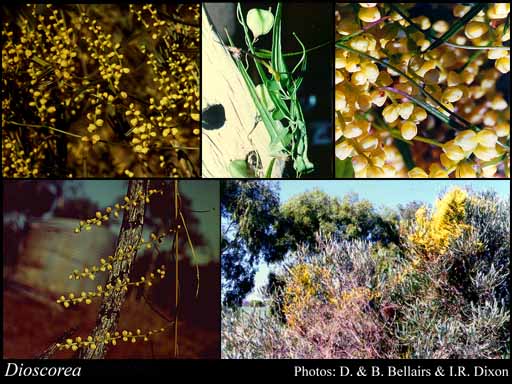- Reference
- Sp.Pl. [Linnaeus] 2:1032 (1753)
- Name Status
- Current

Scientific Description
Common name. Dioscoreas. Family Dioscoreaceae.
Habit and leaf form. Shrubs, or herbs. Perennial (above ground parts annual or perennial). Leaves cauline. Cormous (woody), or rhizomatous, or tuberous (all store starch). Climbing, or self supporting; stem twiners, or scrambling. Mesophytic, or xerophytic. Leaves alternate, or opposite; spiral; petiolate; sheathing to non-sheathing; simple, or compound; when compound, palmate, or multiply compound. Leaf blades entire, or dissected; ovate, or triangular (narrowly or broadly), or linear; when incised, palmately lobed; basically palmately veined; cross-venulate; cordate, or hastate, or rounded at the base (or truncate). Leaves without stipules. Leaf anatomy. Hairs absent. Extra-floral nectaries absent. Stem anatomy. Secondary thickening absent, or anomalous; when present, from a single cambial ring. Roots. Roots with velamen (single layered), or without velamen.
Reproductive type, pollination. Fertile flowers functionally male and functionally female, or functionally male, or functionally female. Unisexual flowers present. Plants monoecious (rarely), or dioecious. Female flowers 3 staminodes present. Male flowers with pistillodes, or without pistillodes.
Inflorescence and flower features. Flowers aggregated in ‘inflorescences’; in racemes, or in spikes. The terminal inflorescence unit racemose. Inflorescences axillary; male flowers in spikes, racemes of small cymes that make up the inflorescence; female flowers often in spikes or spike-like racemes or racemes that make up the inflorescence. Flowers pedicellate, or sessile (male flowers); bracteate (1 subtends each flower, minute); bracteolate; small (generally inconspicuous); regular; 3 merous. Perigone tube usually present (short). Perianth of ‘tepals’; 6; 2 -whorled; isomerous; joined; sepaloid, or petaloid; similar in the two whorls, or different in the two whorls; green (pale), or white (to purple-brown), or yellow. Fertile stamens present, or absent. Androecial members definite in number. Androecium 6. Androecial members adnate; all equal; free of one another; 2 -whorled. Androecium exclusively of fertile stamens. Stamens 6 (in 2 whorls); all more or less similar in shape; diplostemonous; on the base of the perianth. Anthers basifixed; dehiscing via longitudinal slits; extrorse, or introrse; appendaged, or unappendaged. Fertile gynoecium present, or absent. Gynoecium 3 carpelled. The pistil 3 celled. Gynoecium syncarpous; synovarious to synstylovarious; inferior. Ovary plurilocular; 3 locular. The ‘odd’ carpel posterior. Gynoecium stylate. Styles 1 (or 3); free, or partially joined; apical. Stigmas 3; 2 - lobed. Placentation axile. Ovules 2 per locule (usually); pendulous; superposed; non-arillate; anatropous.
Fruit and seed features. Fruit fleshy, or non-fleshy; dehiscent; a capsule. Capsules loculicidal. Fruit 3 celled; 3–6 seeded. Seeds endospermic. Endosperm oily. Seeds winged. Embryo well differentiated (small). Cotyledons 1, or 2. Testa without phytomelan (but with red to yellowish brown phlobaphene).
Economic uses, etc. Yams.
Etymology. After Pedianos Dioscorides, Greek physician of the 1st century AD whose book on medicinal herbs Materia medica, was a standard work until comparatively recent times.